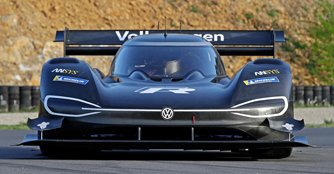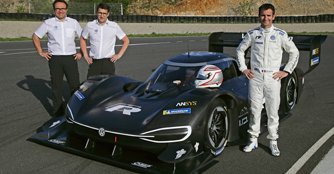Lightweight design strategy defines Volkswagen I.D. R Pikes Peak
27 May 2018|2,640 views
In preparation for the Pikes Peak International Hill Climb 2018, the Volkswagen Motorsport team designed the I.D. R Pikes Peak to strike the best balance between performance and weight. The brand's first fully-electric racing car will take on the most famous hill climb in the world on 24th June in Colorado Springs, CO, aiming to break the record in the class for electric prototypes, which currently stands at 8:57.118 minutes.

The trials focussed on finding the optimal compromise between performance and weight. Both factors are more dependent on each other in an electric car than in a racing car with a conventional combustion engine.
The simple rule of thumb is the greater the performance, the heavier the batteries required. However, every single gram is unwanted weight, particularly at a hill climb. On Pikes Peak, the cars must overcome a difference in altitude of more than 1,432m on the way to the finish line. Romain Dumas, at the wheel of the I.D. R Pikes Peak, will also be faced with a series of hairpin turns, where a heavy car would be a disadvantage when braking and accelerating out of corners.
Volkswagen Motorsport engineers decided on the following strategy; the I.D. R Pikes Peak was to be as light as possible, while still maintaining a very high level of performance. Fortunately, there are essentially no regulations for the 'Unlimited' class at Pikes Peak, giving the team complete design freedom.
Being given the proverbial blank sheet of paper and told to develop a new racing car from scratch is a dream for any engineer. "To develop a car solely for this 20km hill climb is a very special task. There were virtually no bounds to the innovation shown by the engineers," said Francois-Xavier Demaison, Technical Director at Volkswagen Motorsport.
"Simulation played a major role in achieving the low weight of the car," said Rampf. For example, computers were used to design chassis parts in such a way that they are able to cope with the anticipated loads without any problems, and without appearing oversized or overweight.
The development team also nearly completely dispensed with the standard, but extremely expensive, materials commonly used in top-class motor racing, such as titanium.
"The chassis, suspension and safety structure of the I.D. R Pikes Peak are almost completely made of steel and aluminium," said Demaison.
Despite this, the car, complete with driver, weighs less than 1,100kg - a lightweight compared to Pikes Peak category electric race cars. A relatively low output of 662bhp allowed the battery components for the I.D. R Pikes Peak to be so compact that they could be positioned next to and behind the driver, thus ensuring perfect weight distribution. They provide the energy for an electric motor on both the front and rear axles, while torque distribution is managed electronically.
The I.D. R Pikes Peak's chassis and aerodynamic components are made of an extremely light carbon fibre and Kevlar composite. One of the tasks faced during the design phase was to integrate design elements from the I.D. family - Volkswagen's future range of fully-electric vehicles - in the exterior of the Pikes Peak racing car. "During this phase of development, we worked particularly closely with our Volkswagen colleagues in Wolfsburg," said Willy Rampf.
The extent to which the engineers were willing to go to reduce weight is exemplified by the driver's equipment. Technology partner OMP made driver Dumas' fire-resistant race suit, as well as the seat padding and six-point harness, from particularly light material. Even the sponsors' logos are printed onto the overall, to save the weight of conventional patches.
However, Volkswagen Motorsport did have to give in on one point. The regulations of the Pikes Peak International Hill Climb stipulate that each driver must wear a large event emblem on their race suit. The plan was to have this logo printed on Dumas' race suit too, but according to the regulations, it has to be sewn on. Demaison joked, "The thread used for that weighs almost as much as the entire suit."
In preparation for the Pikes Peak International Hill Climb 2018, the Volkswagen Motorsport team designed the I.D. R Pikes Peak to strike the best balance between performance and weight. The brand's first fully-electric racing car will take on the most famous hill climb in the world on 24th June in Colorado Springs, CO, aiming to break the record in the class for electric prototypes, which currently stands at 8:57.118 minutes.

The trials focussed on finding the optimal compromise between performance and weight. Both factors are more dependent on each other in an electric car than in a racing car with a conventional combustion engine.
The simple rule of thumb is the greater the performance, the heavier the batteries required. However, every single gram is unwanted weight, particularly at a hill climb. On Pikes Peak, the cars must overcome a difference in altitude of more than 1,432m on the way to the finish line. Romain Dumas, at the wheel of the I.D. R Pikes Peak, will also be faced with a series of hairpin turns, where a heavy car would be a disadvantage when braking and accelerating out of corners.
Volkswagen Motorsport engineers decided on the following strategy; the I.D. R Pikes Peak was to be as light as possible, while still maintaining a very high level of performance. Fortunately, there are essentially no regulations for the 'Unlimited' class at Pikes Peak, giving the team complete design freedom.
Being given the proverbial blank sheet of paper and told to develop a new racing car from scratch is a dream for any engineer. "To develop a car solely for this 20km hill climb is a very special task. There were virtually no bounds to the innovation shown by the engineers," said Francois-Xavier Demaison, Technical Director at Volkswagen Motorsport.
"Simulation played a major role in achieving the low weight of the car," said Rampf. For example, computers were used to design chassis parts in such a way that they are able to cope with the anticipated loads without any problems, and without appearing oversized or overweight.
The development team also nearly completely dispensed with the standard, but extremely expensive, materials commonly used in top-class motor racing, such as titanium.
"The chassis, suspension and safety structure of the I.D. R Pikes Peak are almost completely made of steel and aluminium," said Demaison.
Despite this, the car, complete with driver, weighs less than 1,100kg - a lightweight compared to Pikes Peak category electric race cars. A relatively low output of 662bhp allowed the battery components for the I.D. R Pikes Peak to be so compact that they could be positioned next to and behind the driver, thus ensuring perfect weight distribution. They provide the energy for an electric motor on both the front and rear axles, while torque distribution is managed electronically.
The I.D. R Pikes Peak's chassis and aerodynamic components are made of an extremely light carbon fibre and Kevlar composite. One of the tasks faced during the design phase was to integrate design elements from the I.D. family - Volkswagen's future range of fully-electric vehicles - in the exterior of the Pikes Peak racing car. "During this phase of development, we worked particularly closely with our Volkswagen colleagues in Wolfsburg," said Willy Rampf.
The extent to which the engineers were willing to go to reduce weight is exemplified by the driver's equipment. Technology partner OMP made driver Dumas' fire-resistant race suit, as well as the seat padding and six-point harness, from particularly light material. Even the sponsors' logos are printed onto the overall, to save the weight of conventional patches.
However, Volkswagen Motorsport did have to give in on one point. The regulations of the Pikes Peak International Hill Climb stipulate that each driver must wear a large event emblem on their race suit. The plan was to have this logo printed on Dumas' race suit too, but according to the regulations, it has to be sewn on. Demaison joked, "The thread used for that weighs almost as much as the entire suit."
Latest COE Prices
September 2025 | 2nd BIDDING
NEXT TENDER: 08 Oct 2025
CAT A$119,003
CAT B$136,890
CAT C$72,501
CAT E$140,502
View Full Results Thank You For Your Subscription.






















